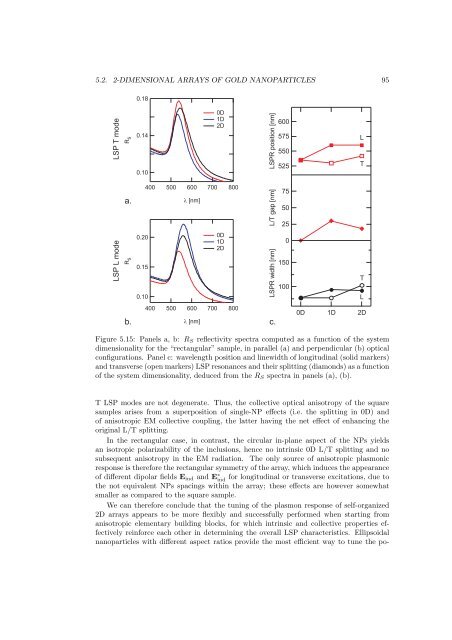94 CHAPTER 5. MODELLING AND ANALYSIS OF THE OPT. PROP.respectively. The corresponding L/T splitting is about 40 nm, while the plasmonlinewidths are Γ 0 L = 148 nm <strong>and</strong> Γ0 L = 81 nm.1D Introducing the EM coupling between NPs belonging to the same chain leads to theappearance <strong>of</strong> an induced field E ind radiated by the neighbouring NPs (see fig. 5.16,top panels). When the electric field is transverse to the chain, E ind counteractsthe external field (red arrow in fig. 5.16(a)), thereby blue shifting the resonance; incontrast, for longitudinal excitation, the induced field adds up to the external field(fig. 5.16(b)), with a corresponding red shift <strong>of</strong> the LSP peak (cfr. §1.3.4) [58, 71–74, 76–78, 85, 86]. Moreover, due to the retardation effects <strong>of</strong> the interactions, theLSPmodesbecomealsobroader. Inourcase, theonset<strong>of</strong>thedipolarcouplingwouldshift the L <strong>and</strong> T resonance peaks (blue curves in fig. 5.14(a, b)) to λ 1 L = 614 nm <strong>and</strong>λ 1 T = 524 nm, respectively, more than doubling the original 0D splitting (90 nm);correspondingly, the LSP widths become Γ 0 L = 187 nm <strong>and</strong> Γ0 L = 83 nm.2D In 2D, the local field acting on each particle acquires dipolar contributions E ∗ ind als<strong>of</strong>rom NPs belonging to neighbouring chains, indicated in blue in fig. 5.16(c, d).For exciting fields both longitudinal <strong>and</strong> transverse to the ripples, E ∗ ind systematicallycounteracts the dipolar field E ind generated by NPs from the same chain (redarrows), thus reducing the LSP shifts observed in the 1D case. Accordingly, thecalculated L mode blue-shifts back to λ L = 600 nm while the T mode redshifts toλ T = 538 nm (black curves in fig. 5.14(a, b)), yielding a L/T splitting <strong>of</strong> 62 nm, inagreement with the experimental observations.For the “rectangular” sample (fig. 5.15) the situation is generally similar, but withsome extremely interesting changes.0D The in-plane spherical aspect <strong>of</strong> the NPs yields degenerate single-particle L <strong>and</strong> TLSPmodes, locatedatλ 0 L = λ0 T = 538nm<strong>and</strong>havingalinewidthΓ0 L = Γ0 T = 77nm,i.e. no L/T splitting in the 0D case.1D The degeneracy is lifted in 1D, due to the presence <strong>of</strong> the dipolar field E ind ; here a30 nm splitting is observed, originating from the simultaneous redshift <strong>of</strong> L excitationsto λ 1 L = 561 nm <strong>and</strong> the blueshift <strong>of</strong> the T peak to λ1 T = 532 nm. The width<strong>of</strong> the L resonances increases to Γ 1 L = 94 nm, Γ T remains unchanged.2D In 2D, the L mode slightly blue shift at λ T = 557 nm, while the T mode redshifts toλ L = 544 nm, finally yielding a L/T splitting <strong>of</strong> merely 18 nm, significantly lowerthan the one observed for the square samples. Correspondingly, the linewidths <strong>of</strong>the resonances increase up to Γ 2 T = 103 nm for the T mode <strong>and</strong> slightly decrease to= 92 nm for the L mode.Γ 2 LInterestingly, we notice that although the NPs lay on a square grid, the L <strong>and</strong> Tpeak positions (<strong>and</strong> their corresponding splitting) in the 2D case are not equivalent totheir 0D value. This happens because the anisotropic polarizability <strong>of</strong> the individual Auinclusions induces a correspondingly anisotropic radiated EM field [68, 72], that furtherreinforces the intrinsic system birefringence. This is schematically represented in panels(c) <strong>and</strong> (d) <strong>of</strong> fig. 5.16. When the external field is applied along the ripples, i.e. parallelto the major axis <strong>of</strong> the ellipsoids, the induced dipoles are weaker than for transversalexcitations. Correspondingly, the irradiated fields E ind <strong>and</strong> E ∗ inddepend on the direction<strong>of</strong> the external field, so, despite the square symmetry <strong>of</strong> the lattice, the collective L <strong>and</strong>
5.2. 2-DIMENSIONAL ARRAYS OF GOLD NANOPARTICLES 950.18LSP L mode LSP T modeR Sa.R S0.140.104000.200.150.10500600 [nm]7000D1D2D0D1D2D800LSPR width [nm] L/T gap [nm] LSPR position [nm]6005755505257550250150100LTTLb.400500600 [nm]700800c.0D 1D 2DFigure 5.15: Panels a, b: R S reflectivity spectra computed as a function <strong>of</strong> the systemdimensionality for the “rectangular” sample, in parallel (a) <strong>and</strong> perpendicular (b) opticalconfigurations. Panel c: wavelength position <strong>and</strong> linewidth <strong>of</strong> longitudinal (solid markers)<strong>and</strong>transverse(openmarkers)LSPresonances<strong>and</strong>theirsplitting(diamonds)asafunction<strong>of</strong> the system dimensionality, deduced from the R S spectra in panels (a), (b).T LSP modes are not degenerate. Thus, the collective optical anisotropy <strong>of</strong> the squaresamples arises from a superposition <strong>of</strong> single-NP effects (i.e. the splitting in 0D) <strong>and</strong><strong>of</strong> anisotropic EM collective coupling, the latter having the net effect <strong>of</strong> enhancing theoriginal L/T splitting.In the rectangular case, in contrast, the circular in-plane aspect <strong>of</strong> the NPs yieldsan isotropic polarizability <strong>of</strong> the inclusions, hence no intrinsic 0D L/T splitting <strong>and</strong> nosubsequent anisotropy in the EM radiation. The only source <strong>of</strong> anisotropic <strong>plasmonic</strong>response is therefore the rectangular symmetry <strong>of</strong> the array, which induces the appearance<strong>of</strong> different dipolar fields E ind <strong>and</strong> E ∗ indfor longitudinal or transverse excitations, due tothe not equivalent NPs spacings within the array; these effects are however somewhatsmaller as compared to the square sample.We can therefore conclude that the tuning <strong>of</strong> the plasmon response <strong>of</strong> <strong>self</strong>-<strong>organized</strong>2D <strong>arrays</strong> appears to be more flexibly <strong>and</strong> successfully performed when starting fromanisotropic elementary building blocks, for which intrinsic <strong>and</strong> collective <strong>properties</strong> effectivelyreinforce each other in determining the overall LSP characteristics. Ellipsoidalnanoparticles with different aspect ratios provide the most efficient way to tune the po-
















